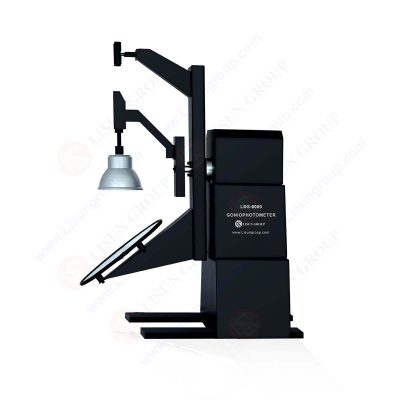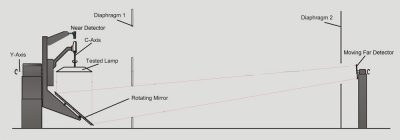LISUN is an independent lighting and optical test laboratory for testing LEDs, lamps, luminaries, displays, signs, and vehicle lighting.
Photometry is the modern science used for the measurement of visible light regarding its perceived vision brightness to the human vision. The SI unit of photometry is lumen (lm).
The two laws used in photometry are inverse square and cosine laws. The inverse square law states that the relation between intensity per unit area on the surface and the square of the distance present between the source and surface is inversely proportional to each other.
On the other hand, according to the cosine law, the intensity of light on the surface of the fixed area varies directly with the incident angle. Most importantly, the intensity drops as the cosine of the angle drops.
Here are some essential photometric terms; you need to understand while doing photometric testing.
Luminous Flux
It is defined as the measure of the total optical output of a visible light source. Luminous flux is expressed in lumens. Luminous flux is defined as the measure of the entire optical work of a visible light source. It is expressed in lumens.
The measurement requires all the power of the source to be concentrated on a detector. It can be a problem with the divergent sources such as the LEDs and all the lamps. In this condition, we mainly use the integrating spheres.
Illuminance
The illuminance of the surface is defined as the amount of light incident upon the surface is divided by the area of the surface. We measure it in either foot candles ( lumens per square foot) or lux ( lumens per square meter).
Luminance Exitance
Luminance existence is considered an intrinsic property of the light source. We define it as the luminous flux divided by the source’s area. Luminance intensity is the measure of the flux emitted into the solid angle.
Luminance
Luminance is defined as the measure of the flux reflected by or emitted from a relatively flat and uniform surface.
It is the approved method. It explains the procedure and precautions to be observed in performing the reproducible measurements of total Luminous flux
• electrical power
• luminous intensity distribution
• chromaticity of solid-state lighting (SSL) products for illumination purposes under standard conditions.
It covers the LED-based SSL products with control electronics, and heat sinks incorporated. Those devices require only AC mains power or a DC voltage power supply. It also covers SSL products in the form of luminaries (fixtures containing light sources) and integrated LED lamps. Units of photometric measurements are known as Lumen and Candela2. We provide the standard photometric data files in IES (.ies) and EULUMDAT (.ldt) formats as per IES LM 79-08.
(Integrating sphere) Sphere Photometer is used to determine the total luminous flux output of light sources and used to measure the light output ratio (LOR) of luminaries. Sphere photometry works on Ulbricht’s theory.
According to this theory, the luminous flux of the light source is in relation with the indirect illuminance on the internal surface of the integrating sphere by
φ =Eind *A* ( 1 – ρ )/ ρ
Eind – represents the Indirect illuminance on the internal surface of the sphere.
And ρ represents the reflectance of the internal surface of the sphere.
A represents the surface area of a sphere
The “k” = A* (1-ρ)/ ρ is known as the “sphere factor.”

LM-79 Moving Detector Goniophotometer LSG-6000
LSG-6000 goniophotometer manufacturer is LISUN. It can measure all lighting sources, LED, Plant Lighting, or HID luminaires such as indoor and outdoor luminaires, roadway luminaires, street lamps, floodlights, and other kinds of luminaires.

• The luminaire under the test rotates around the mirror with an angle of the vertical axis 180 degrees.
• The luminaire makes a rotation around itself with an angle of horizontal axis 180 degrees.
• Accuracy of the curve: 0.05
• Resolution of the angle: 0.001
• Accuracy of the goniophotometer detector: Constant temperature photodetector
• The LISUN goniophotometer can easily export the CIE, IES, LDT, and other format files.
• You can use the LSG-6000 and the CCD Spectrophoto Radiometer to test the spatial CCT distribution.
• Luminous Intensity Data
• Photometric Data
• Luminous Intensity Distribution
• Zonal Luminous Flux
• Luminaries Efficiency
• Luminance Distribution
• Coefficient Of Utilization
• Luminance Limitation Curves Glare
• Maximum Ratio of Distance to Height
• Equal Illuminance Diagrams
• Curves of Luminaires VS Lighting Area
• Isocandela Diagrams
• Efficient Luminescence Angle
• EEI, UGR, etc.

LSG-6000 Moving Detector Goniophotometer Working Principle

LSG-5000 Moving Detector Goniophotometer Dark Room
• The near field detector is present. It moves together with the significant mirror current in the line. The big mirror and the far-field sensor move simultaneously.
• The burning position of the luminaries will not be moving at all. The detector will always sense the light coming directly from the luminaries.
• The rotary motor is from Japan MITSUBISHI MOTORS, and the angle decode system is from Germany.
• They help the goniophotometer to rotate smoothly with high accuracy. It is very stable when it starts and stops.
• The working principles are according to IESNA and CIE. The LSG-6000 meets the LM-80, LM-79, LM-75, GB, EN, and CIE 121-1996 standards.
• Special collimation device with a cross laser line is present. It helps you install the luminaires’ position under test conveniently and accurately.
| LISUN Model | Testing Lamp Size (Diameter E* Depth F) | Measure Power (W) | Minimum dark room height |
| LSG-6000/LSG-6000CCD (Standard Size) | max Φ1600*600mm, 50kg | max 600V/10A, AC/DC | 4.1m |
| LSG-6000L/LSG-6000 LCD (Super Big Size) | max Φ2000*900mm, 80kg | max 600V/10A, AC/DC | 5.2m |
| LSG-6000B/LSG-6000BCCD (Big Size) | max Φ1800*800mm, 60kg | max 600V/10A, AC/DC | 4.7m |
| LSG-6000S/LSG-6000SCCD (Small Size) | max Φ1200*500mm, 40kg | max 600V/10A, AC/DC | 3.0m |
A goniophotometer is a photometric device. It is used to measure the perceived power of a light source at different angles.
Photometry is the modern branch of science that deals with the measurement of intensity of the light.
Lisun Instruments Limited was found by LISUN GROUP in 2003. LISUN quality system has been strictly certified by ISO9001:2015. As a CIE Membership, LISUN products are designed based on CIE, IEC and other international or national standards. All products passed CE certificate and authenticated by the third party lab.
Our main products are Goniophotometer, Integrating Sphere, Spectroradiometer, Surge Generator, ESD Simulator Guns, EMI Receiver, EMC Test Equipment, Electrical Safety Tester, Environmental Chamber, Temperature Chamber, Climate Chamber, Thermal Chamber, Salt Spray Test, Dust Test Chamber, Waterproof Test, RoHS Test (EDXRF), Glow Wire Test and Needle Flame Test.
Please feel free to contact us if you need any support.
Tech Dep: Service@Lisungroup.com, Cell/WhatsApp:+8615317907381
Sales Dep: Sales@Lisungroup.com, Cell/WhatsApp:+8618117273997
Your email address will not be published. Required fields are marked *